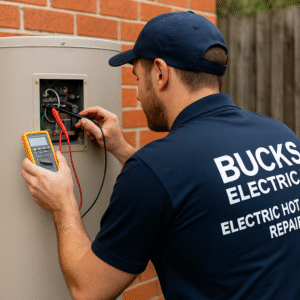Upgrading your home’s electrical panel is a crucial step for safety, efficiency, and supporting modern energy demands. Whether you are adding high-powered appliances, EV chargers, or smart home systems, knowing the electrical panel change cost helps homeowners plan their budget effectively.
Estimating this cost can be complicated because multiple factors influence the final price. In this guide, we’ll break down what contributes to the electrical panel change cost, provide tips for accurate estimates, and help homeowners make informed decisions when upgrading their electrical system.
Understanding Electrical Panels
An electrical panel, also called a breaker panel or service panel, distributes electricity throughout your home. It ensures each circuit receives the appropriate power and protects your system from overloads.
Older panels may struggle with the demands of modern homes. Common issues include frequent breaker trips, outdated breakers, or insufficient amperage. Changing your electrical panel addresses these issues and provides the capacity needed for today’s energy requirements.
Understanding the role of the panel is key to estimating the electrical panel change cost accurately.
Factors Affecting Electrical Panel Change Cost
Several elements influence the electrical panel change cost, including panel type, size, labor, materials, permits, and additional upgrades. Let’s explore these factors in detail.
1. Panel Size
Panel size, measured in amperage, is one of the most significant determinants of cost. Typical sizes include:
-
100-amp panels: Suitable for older homes with basic power needs.
-
150–200 amp panels: Standard for most modern homes.
-
400-amp panels: For large homes, workshops, or homes with EV chargers.
A larger panel requires more materials, more breakers, and additional labor, which increases the electrical panel change cost.
2. Panel Type
The type of panel selected also affects the price:
-
Standard Load Centers: Affordable and sufficient for many homes.
-
Main Breaker Panels: Include a main shut-off breaker for added safety.
-
Main Lug Panels: Typically less expensive but require a separate disconnect.
-
Smart Panels: Offer monitoring, surge protection, and remote control but cost more upfront.
Choosing the right panel ensures your electrical panel change cost aligns with your home’s needs.
3. Labor Costs
Labor is a major component of the electrical panel change cost. Factors that affect labor include:
-
Electrician Rates: Hourly rates vary by location, experience, and licensing.
-
Project Complexity: Relocating panels, rewiring, or adding circuits increases labor hours.
-
Permit Handling: Licensed electricians usually manage permits and inspections, impacting labor costs.
Hiring a professional ensures the panel is installed safely and up to code while influencing the overall electrical panel change cost.
4. Material Costs
Materials include the panel itself, breakers, wiring, connectors, and grounding equipment. Material choices significantly affect the electrical panel change cost:
-
Panel Brand and Size: Larger panels or premium brands cost more.
-
Wiring Upgrades: Older wiring may need replacement to support modern loads.
-
Safety Features: Surge protection, grounding rods, and quality breakers add to material expenses.
Using high-quality materials may increase the initial electrical panel change cost, but it ensures long-term safety and efficiency.
5. Home Location and Accessibility
Where your home is located and how accessible the panel is can influence costs:
-
Urban vs. Rural Areas: Labor and permit fees vary by region.
-
Panel Accessibility: Panels in tight or hard-to-reach spaces require more labor.
-
Local Electrical Codes: Some municipalities have stricter requirements, impacting installation costs.
These factors cause the electrical panel change cost to vary from one home to another.
6. Additional Electrical Work
Upgrading your panel may involve extra work that affects the total cost:
-
Rewiring Circuits: Replacing old or damaged wiring is often necessary.
-
Adding Dedicated Circuits: High-demand appliances, home offices, or EV chargers may need extra circuits.
-
Panel Relocation: Moving the panel for convenience or compliance adds labor and materials.
Including these factors ensures that your electrical panel change cost estimate reflects the full scope of the project.
7. Permits and Inspection Fees
Most municipalities require permits and inspections for panel replacements.
-
Permit Costs: Range from $50 to $500 depending on location.
-
Inspections: Required to verify code compliance and safety.
Failing to account for these fees can underestimate the electrical panel change cost.
8. Age and Condition of Your Electrical System
Older homes often have outdated panels, aluminum wiring, or insufficient grounding, which can increase labor and material needs:
-
Outdated Panels: May require full replacement rather than partial upgrades.
-
Aluminum Wiring: May need replacement for safety.
-
Grounding and Bonding: Additional work may be needed to meet current codes.
Newer homes with modern electrical systems generally have lower electrical panel change cost estimates.
Average Electrical Panel Change Cost
The electrical panel change cost can vary based on the factors above:
-
100-amp panel: $1,000–$1,500
-
150–amp panel: $1,200–$2,000
-
200-amp panel: $1,500–$3,000
-
400-amp panel: $2,500–$5,000+
These estimates include labor, materials, and permits, but additional work such as rewiring or panel relocation can increase the cost.
Tips for Estimating Electrical Panel Change Cost
-
Gather Multiple Quotes: Compare estimates from licensed electricians.
-
Consider Your Home’s Needs: Factor in high-demand appliances, EV chargers, and future expansion.
-
Include Optional Safety Features: Surge protection and energy monitoring add value.
-
Check Local Costs: Labor, permits, and materials vary by location.
-
Hire Licensed Professionals: Ensures safety, code compliance, and reduces risk of errors.
By addressing these factors, homeowners can estimate the electrical panel change cost more accurately and plan their budget accordingly.
Benefits of Accurate Cost Estimation
Knowing your electrical panel change cost in advance offers several benefits:
-
Financial Planning: Avoid unexpected expenses by budgeting properly.
-
Safety Assurance: Ensures the upgrade meets code and safety requirements.
-
Efficient Installation: Professionals can plan labor and materials based on accurate cost estimates.
-
Peace of Mind: Homeowners can invest confidently in a modern, reliable electrical system.
Accurate estimation ensures a smooth, cost-effective, and safe electrical panel upgrade.
Conclusion
Estimating the electrical panel change cost involves understanding multiple factors, including panel size, type, labor, materials, permits, location, additional work, and the condition of your home’s electrical system. Proper planning and professional guidance ensure that the upgrade is safe, efficient, and cost-effective.
For homeowners seeking reliable estimates, professional installation, and safe, code-compliant solutions, Madison Electric Company provides expert services to handle electrical panel change cost projects. Their team ensures accurate budgeting, quality materials, and expert installation for a safe and efficient home electrical system.

